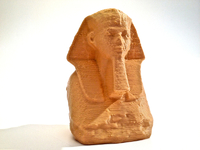 An interesting experiment took place at New York City’s Metropolitan Museum of Art recently, in which the Met tag-teamed with MakerBot to produce 3D art models.
An interesting experiment took place at New York City’s Metropolitan Museum of Art recently, in which the Met tag-teamed with MakerBot to produce 3D art models. A team of folks from MakerBot were invited by the Met to journey through several collections to perform 3D scans of famous artwork. The scans were then converted into 3D models and stored for public use on Thingiverse. You can see these excellent models yourself at Thingiverse by searching for tag “Met3D”.
How was this done? Not with expensive mobile 3D scanners, nor by expensive human 3D modelers. Instead the team simply captured a number of still images of each artwork and then fed them into Autodesk’s increasingly useful online 123D Catch service. 123D analyzes the images and converts them into a 3D model. After some 3D model tweaking, great models appeared on Thingiverse.
We think this was a tremendous experiment with fantastic results that all can share. But there is a dark side, too. Essentially, people entered a museum and took photographs, a practice commonly permitted in many museums. This experiment showed that a team, with permission or not, could invade any museum and capture at least rudimentary 3D models of the exhibits. Is this good or evil? We suppose it depends on who you are.
Meanwhile, we’re busy 3D printing some Sphinxes.


You need a lot of photos of an object to get a good scan – I think autodesk recommends around 50 – and the pattern of camera movement will be fairly easy to spot. So museum staff will notice, and can act to interrupt the "scanning" if their policy requires it. Lots of museums and galleries forbid _any_ form of photography.
And at least it guarantees that the photographers not be using flash, since flash lighting ruins the software's ability to recognise shadows.
It's not as if the printed results from currently available printers will ever be mistaken for original valuable art-works. 3D printers don't have the material flexibility yet to make believable counterfeits. It's more like taking a 3D photograph, and looking at it later on your stereoscopic viewer. People have been able to do that for decades.
You need a lot of photos of an object to get a good scan – I think autodesk recommends around 50 – and the pattern of camera movement will be fairly easy to spot. So museum staff will notice, and can act to interrupt the "scanning" if their policy requires it. Lots of museums and galleries forbid _any_ form of photography.
And at least it guarantees that the photographers not be using flash, since flash lighting ruins the software's ability to recognise shadows.
It's not as if the printed results from currently available printers will ever be mistaken for original valuable art-works. 3D printers don't have the material flexibility yet to make believable counterfeits. It's more like taking a 3D photograph, and looking at it later on your stereoscopic viewer. People have been able to do that for decades.